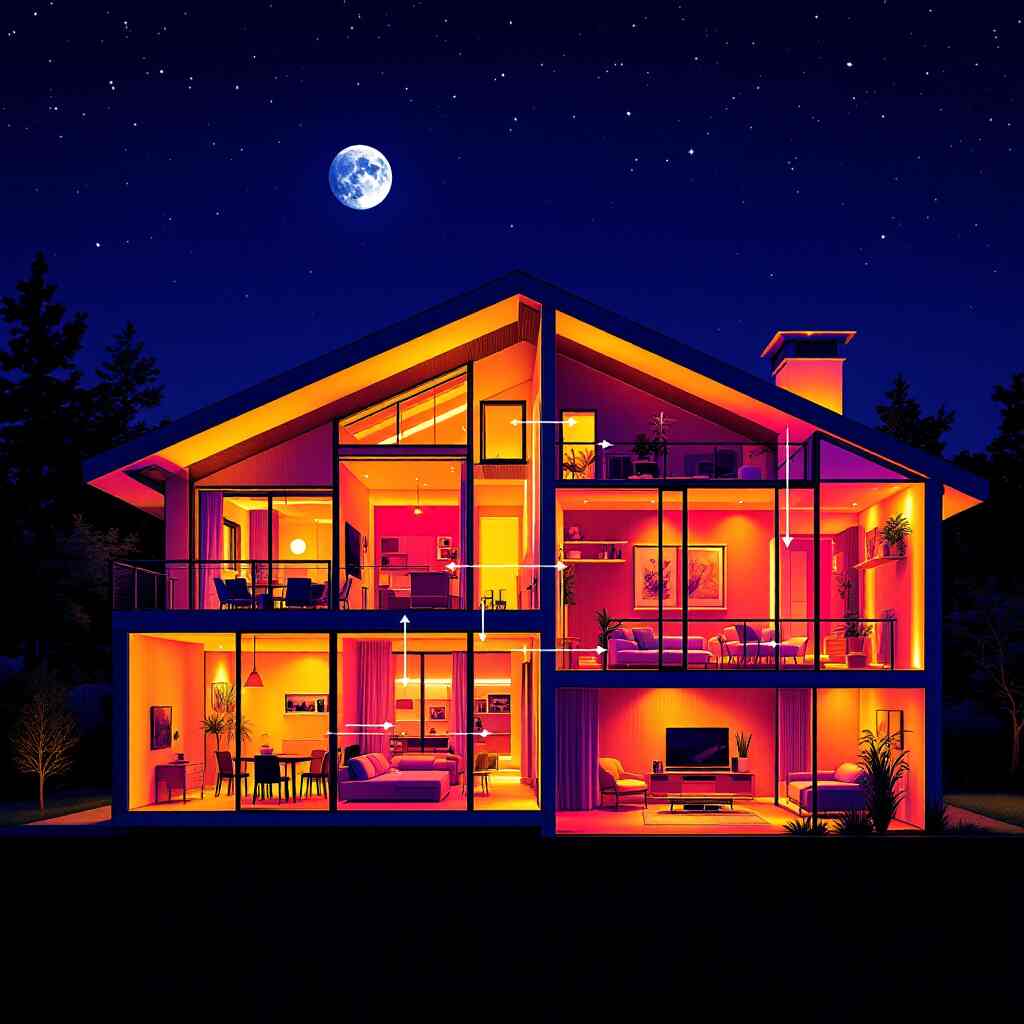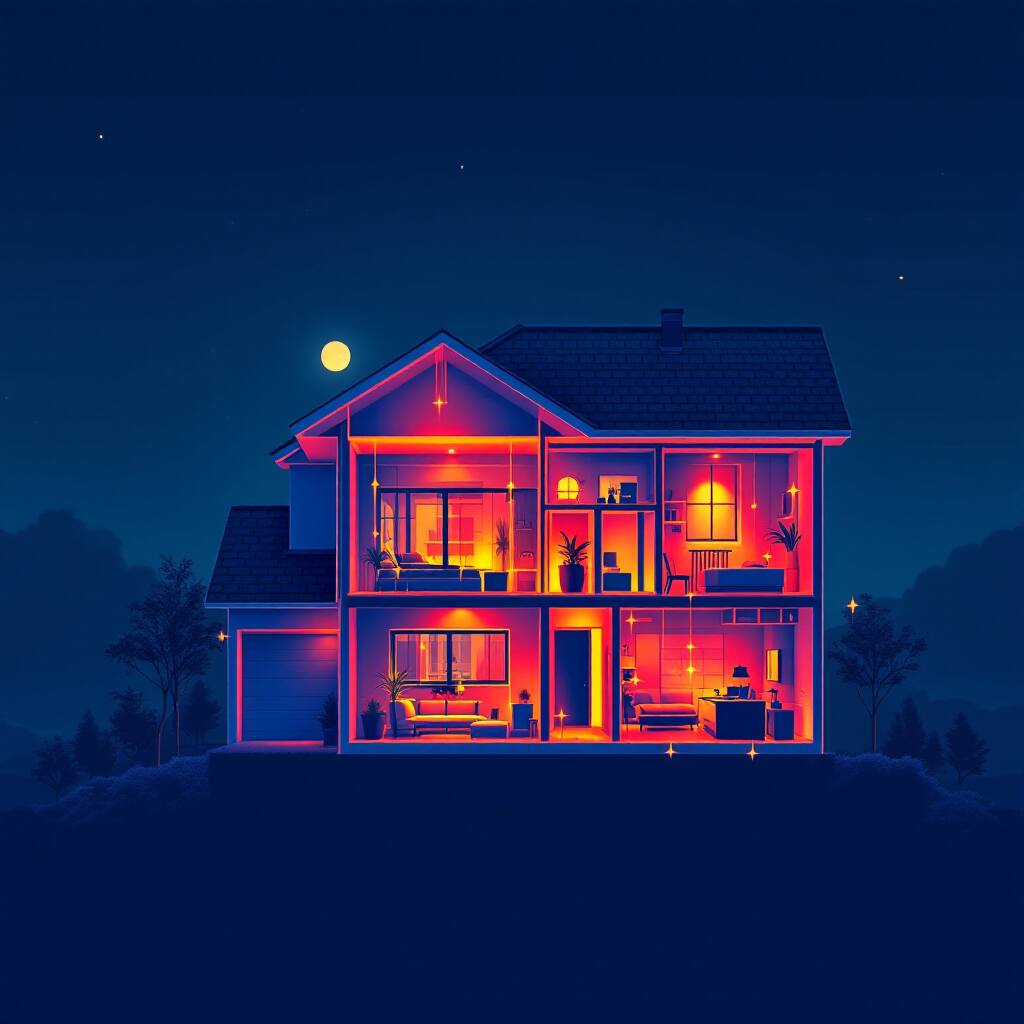Have you ever wondered, “Why does my house get hot at night?” Even when the outdoor temperature drops after sunset, your home might still feel uncomfortably warm. This is a common issue faced by many homeowners, and understanding its causes is the first step toward improving Comfort and energy efficiency.
Why Does My House Get Hot at Night? The Science Behind Nighttime Heat
Many homes experience a temperature rise at night despite cooler outdoor temperatures. Why does this happen? The answer lies in some basic principles of thermal dynamics and how Heat interacts with the materials in your home.
Thermal Inertia: Storing and Releasing Heat
Materials like concrete, bricks, and roofing shingles have thermal inertia, meaning they absorb Heat during the day and release it slowly over time. When the sun sets, the Heat stored in these materials doesn’t just disappear—it begins to radiate into your home, contributing to nighttime warmth.
For example, your roof absorbs sunlight all day, storing Heat like a giant thermal battery. Once the outside air cools down, that Heat starts to move inward, warming your living spaces.
Heat Transfer Mechanisms
Heat naturally flows from warmer areas to cooler ones, which means any heat trapped in your roof, walls, or attic will move toward the cooler, air-conditioned rooms in your house. Poor insulation can accelerate this process, making it harder for your home to stay cool at night.
Roof and Solar Radiation
Your roof is the first line of defense against the sun’s rays. During the day, it absorbs a significant amount of solar radiation. Without proper ventilation or reflective coatings, this Heat gets trapped and slowly seeps into your home at night.
Primary Sources of Nighttime Heat in Your Hom
Now that we understand the science let’s break down the specific sources of nighttime Heat in your home.
You may also read (do mormons celebrate christmas with home decorations).
Roof and Attic Heat Storage
Your roof and attic are the biggest contributors to nighttime Heat. Studies suggest that they account for 25-35% of indoor heat gain. Materials like asphalt shingles and tiles absorb Heat during the day and release it into your attic, which then transfers it to your living spaces.
Pro Tip: Installing radiant barriers or increasing attic ventilation can significantly reduce heat transfer.
Internal Heat Sources
Appliances, lighting, and even human body heat contribute to indoor warmth. For example:
- Incandescent bulbs emit both light and Heat.
- Appliances like ovens, dishwashers, and computers release Heat when running.
- The average human body generates about 98.6°F (37°C) of Heat—multiply that by the number of people in your home!
Poor Insulation
If your home’s insulation is old, compressed, or degraded, it won’t effectively block heat transfer. Factors like moisture, dust, and aging can reduce insulation performance over time, allowing Heat to seep into your home more easily.
Heat Penetration Through Windows and Walls
Windows and walls are another major source of heat retention. Single-pane windows or uninsulated walls allow sunlight to penetrate during the day, which gets trapped and slowly radiates out at night.
Structural Design Factors
The design of your home can also affect heat distribution:
- Upper floors tend to be warmer because Heat rises.
- Poorly placed windows or lack of ventilation can trap warm air.
- Homes with dark-colored exteriors absorb more Heat compared to lighter-colored ones.
Common Reasons Your House Feels Hotter at Night
At this point, you might still be wondering, why does my house feel hotter at night than outside? Here are some additional factors that explain this phenomenon:
You may also read (the financial responsibility of house inspections explained).
- Heat Release from Walls, Roof, and Floors
- Even after the sun sets, the materials in your home continue to release stored Heat, keeping the indoor temperature elevated.
- Inadequate Ventilation
- Without proper airflow, hot air gets trapped inside your home. Closed doors, blocked vents, or an inefficient HVAC system can make it harder for Heat to escape.
- Daytime Sunlight Exposure
- If your home gets direct sunlight for most of the day, the heat buildup will linger into the night. Large windows without thermal curtains or shades are especially problematic.
- Insulation and Architectural Design
- Homes with poor insulation or older designs tend to retain more Heat. Modern energy-efficient designs help mitigate this issue by incorporating better materials and ventilation systems.
How Poor Ventilation and Airflow Contribute to Nighttime Heat
Proper ventilation is essential for maintaining a comfortable indoor temperature, especially at night. Here’s why:
Stagnant Air Traps Heat
When air doesn’t circulate properly, it becomes stagnant and traps heat. This is particularly noticeable in areas like bedrooms or closed-off spaces.
Blocked Vents and Closed Doors
Blockages in your HVAC system or keeping doors closed can restrict airflow, preventing hot air from escaping and cool air from circulating.
HVAC System Inefficiencies
If your HVAC system isn’t working efficiently, it may struggle to remove Heat from your home. Regular maintenance, filter changes, and duct cleaning can improve its performance.
The Role of Insulation in Nighttime Heat Retention
Insulation is your home’s shield against unwanted heat transfer—but it’s not foolproof.
How Insulation Works
Insulation materials slow down heat transfer, helping maintain a stable indoor temperature. However, if insulation is poorly installed or maintained, it can trap Heat instead of blocking it.
Common Insulation Problems
- Aging: Over time, insulation materials lose their effectiveness.
- Moisture: Water damage can reduce insulation’s thermal resistance.
- Dust and Compression: Dust buildup or compressed insulation can create gaps that allow Heat to pass through.
Tips for Insulation Maintenance
- Inspect your insulation every few years.
- Seal gaps and cracks in your walls or attic.
- Consider upgrading to modern materials like spray foam or reflective insulation.
Practical Solutions to Reduce Nighttime Heat
Feeling the Heat? Here are actionable steps to keep your home cooler at night:
Roof and Attic Improvements
- Install cool roof coatings to reflect sunlight.
- Add radiant barriers to reduce heat absorption.
- Improve attic ventilation with fans or vents.
Enhance Insulation
- Upgrade to high-performance materials like spray foam.
- Seal leaks in your walls, roof, and windows.
- Regularly check and maintain insulation for maximum efficiency.
Improve Ventilation
- Use cross-ventilation techniques (open windows on opposite sides of the house).
- Install attic fans to expel trapped Heat.
- Optimize your HVAC system by cleaning filters and ensuring proper airflow.
Window Treatments
- Use thermal curtains or reflective films to block sunlight.
- Install double-pane windows to improve insulation.
Behavioral Adjustments
- Avoid using heat-generating appliances at night.
- Choose breathable bedding materials like cotton or bamboo.
Landscaping Tips
- Plant shade trees or add vegetation around your home to block sunlight.
- Use pergolas or awnings to reduce direct sun exposure on windows.
Benefits of Addressing Nighttime Heat Issues
Taking steps to reduce nighttime Heat can lead to:
Benefit Explanation
Improved Comfort: Better sleep quality and overall Comfort at night.
Lower energy bills Reduce reliance on air conditioning and save money.
Environmental Impact Less energy consumption means a smaller carbon footprint.
Increased Home Value Energy-efficient upgrades are attractive to potential buyers.
HVAC Longevity Reduces strain on your HVAC system, extending its lifespan.
When to Consult Professionals
If DIY solutions aren’t enough, it may be time to call in the experts.
Signs You Need Help
- Persistently high indoor temperatures despite efforts to cool your home.
- Visible signs of insulation damage or roof wear.
- Inefficient HVAC performance.
Benefits of Professional Assistance
- Energy Audits: Professionals can identify hidden heat sources.
- Expert Repairs: Proper insulation, roofing, and ventilation installations.
- Rebates: Many energy-efficient upgrades come with government incentives.
You may also read (colorados home real estate license law).
